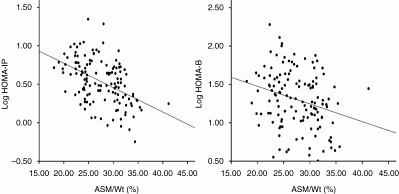ICEECE2012 Poster Presentations Diabetes (248 abstracts)
Sarcopenic phenotype in patients with newly diagnosed type 2 diabetes
J. Son 1 , H. Jeong 1 , S. Lee 1 , S. Kim 1 , D. Kim 2 & S. Yoo 1
The Hallym University, Seoul, Republic of Korea.
Objective - Sarcopenic phenotype is associated with the increased risk of insulin resistance and type 2 diabetes. We investigated the proportion of sarcopenia and sarcopenic obesity (SO) and their clinical characteristics in patients with newly diagnosed type 2 diabetes.
Research design and methods - We conducted a cross-sectional analysis of 133 (75 men, 58 women) patients with newly diagnosed type 2 diabetes. All patients underwent a 75 g oral glucose tolerance test. Sacopenia was assessed by appendicular skeletal muscle mass(ASM)/weight (%) using dual-energy X-ray absorptiometry and obesity was assessed by a visceral fat area using computed tomography.
Results - The mean age of the subjects was 47±12 years, the mean HbA1c level was 10.59±1.94% and the mean body mass index was 25.5±3.4 kg/m2. ASM/weight (%) was inversely associated with the log-transformed homeostasis model assessment of insulin resistance (HOMA-IR) and HOMA-β. The proportion of obesity, sarcopenia and SO was 23.3%, 16.5% and 35.3%, respectively. Sarcopenic phenotype was more prevalent in women than in men (Sarcopenia 29.3% vs. 6.7% and, SO 44.8% vs. 28%, respectively). In comparison to normal phenotype (neither obese nor sarcopenia), SO was significantly associated with higher degree of HOMA-β and the surrogate markers of insulin resistance (HOMA-IR and insulin sensitivity index composite). Notably, SO subjects were more insulin resistant compared to obese without sarcopenia subjects, although there was no significant difference in HbA1c between two groups.
Conclusions - We found the high proportion of sarcopenia and SO in patients with newly diagnosed type 2 diabetes. Among metabolic phenotype, SO was strongly associated with the degree of insulin resistance and compensated hyperinsulinemia in the early phase type 2 diabetes.
| Male(%) | Female(%) | Total(%) | |
| Normal | 24(32.0) | 9(15.5) | 33(24.8) |
| Sarcopenia | 5(6.7) | 17(29.3) | 22(16.5) |
| Obesity | 25(33.3) | 6(10.4) | 31(23.3) |
| Sarcopenic Obesity | 21(28.0) | 26(44.8) | 47(35.3) |
| total | 75(100) | 58(100) | 133(100) |

Relationship of sarcopenic index with log HOMA-IR and logHOMA-B
Declaration of interest: The authors declare that there is no conflict of interest that could be perceived as prejudicing the impartiality of the research project.
Funding: This research did not receive any specific grant from any funding agency in the public, commercial or not-for-profit sector.
 }
}



